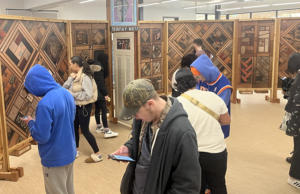Interactive exhibit full of stories to learn from

By Alex Hebert
NORTH BAY – A group of Northern Secondary School students from Sturgeon Falls traveled to the Nipissing University/Canadore College campus in North Bay on Feb. 8 to bear witness to the experience and aftermath of the Indian Residential School through the Witness Blanket exhibit.
The exhibit is a replica of a bigger installation (five times bigger) at the Canadian Museum for Human Rights in Winnipeg, Manitoba, by artist Carey Newman. The blanket is made to bear witness. It collects and holds many truths and stories containing hundreds of items reclaimed from Indian Residential Schools, churches, government buildings, and traditional and cultural structures from across Canada, and accompanied by the voices of Indian Residential School Survivors and their experiences.
“The stories here detail the experiences of Residential School Survivors. Together, they provide a glimpse into the trauma that colonialism sends rippling through generations. Some of them are heart-wrenching, some of them are courageous. All of them speak to the strength and resilience of Indigenous peoples and cultures,” states Newman in a welcome video that speaks about the Witness Blanket. “In the oral traditions of my ancestors, a witness has an important role. To ensure that things are not forgotten, a witness watches, listens, and then remembers and shares with others what they have learned.”
Participants can bear witness through learning and active participation in the reconciliation process. To bear witness is to hear the injustices of the past.
Visitors to the exhibit should bring their phones with them as there is an interactive component to it. Stories, images, photos, and videos can be accessed through witnessblanket.ca/explore. All of the blanket is clickable and some of the links lead to in-depth stories and videos to learn more about a person or item.
Along with exploring the blanket online, there is a teacher guide and a resource guide on witnessblanket.ca, especially for those who are unable to attend the exhibit in-person. The teacher guide comes with the acknowledgment that teaching about Indian Residential Schools and the genocide of Indigenous peoples in Canada can be difficult for both teachers and students.
The resource positions teachers as guides moving alongside students as they learn, empathize, and act together. Also, there is a warning that states, “You and your students may feel sadness, outrage, and anger learning about Residential Schools. This is good: these emotions are essential as we build empathy and personal connections to lead to taking action.”
There is a lot of learning to do through this website and would be fun to do as a classroom activity.
I heard my friend and educator Kelly Crawford once say that before we have reconciliation, we must hear the truth. She would say: “We need to rip off the Band-Aid!” This installation is the truth part. Our learning and what we do with that is the reconciliation part.
If you are ever in Winnipeg, check out the Canadian Museum for Human Rights. They often have exhibits on various First Nation activists such as the Anishinabek Nation Citizenship Commissioner Jeannette Corbiere Lavell (Keewednanung) from Wiikwemkoong Unceded Territory.
The Witness Blanket exhibit is in North Bay until February 16.
Alex Hebert, Dokis First Nation, is a Grade 12 student and resides in Sturgeon Falls. Alex is created the first LEGO Treaty of Niagara wampum belt at age 7.


